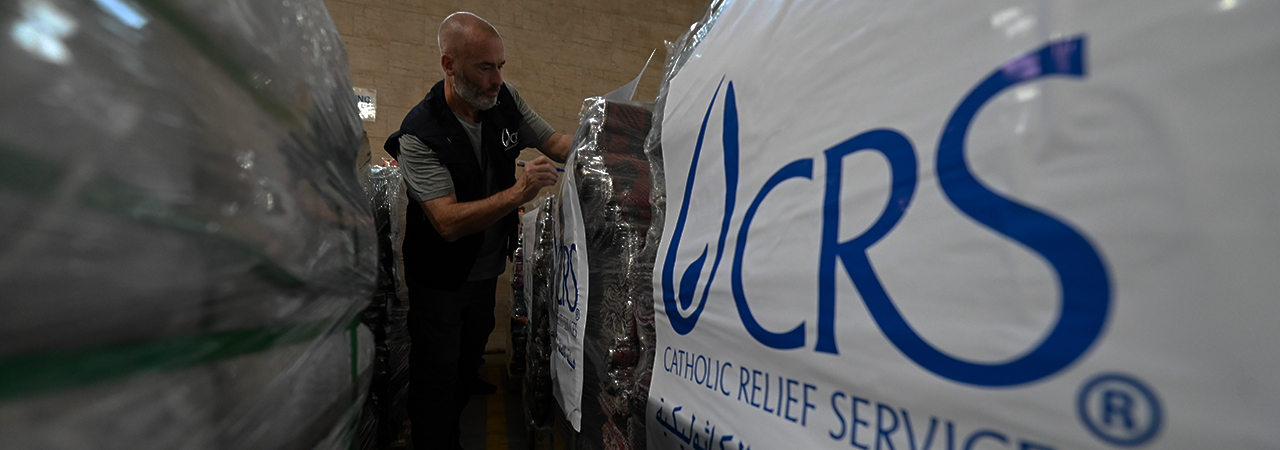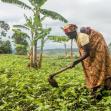

Media CenterCRS' Eight Global Humanitarian Crises to Watch in 2024
FOR IMMEDIATE RELEASE
CONTACT:
Brittany Wichtendahl
Catholic Relief Services
757-748-5003
[email protected]
BALTIMORE, MARYLAND, Dec. 19, 2023 – Ahead of the new year, Catholic Relief Services (CRS), the international relief and development agency of the United States Catholic Church, listed its most pressing humanitarian crises to watch in 2024. The humanitarian catastrophe in Gaza, the ongoing war in Ukraine, compounded crises in the Sahel region of sub-Sahara Africa, and the global food crisis top the list.
“As we go into the New Year, millions of people across the world are experiencing deprivation, loss and disruption to their lives, due to circumstances beyond their control,” said Caroline Brennan, CRS’ emergency communications director. “A moment of crisis can change the trajectory of people’s lives, and have ripple effects that last years, especially for those who are exposed to extreme, life-threatening danger and hunger. We have to mobilize our collective efforts in aid, advocacy, funding and prevention to help people not only survive but have the means for recovery and resilience.”
This year, according to the United Nations’ June 2023 Global Humanitarian Overview, more than 360 million people needed humanitarian assistance, at a cost of nearly $55 billion, but only 20% of this need has been met by the international community. This gap between need and assistance pledged is the highest ever.
“The global food crisis has demonstrated how interconnected we are. A war in one part of the world causes starvation in another,” said Brennan. Other humanitarian crises on CRS’ 2024 watch list include the crises in Afghanistan and Sudan.
“The U.S. has been a leader in providing humanitarian aid in times of historic need,” said David Cronin, a senior policy and legislative specialist for CRS. “This is one of those times. No matter where you look, people are in desperate need of a lifeline. As the calendar year ends, Congress must pass emergency appropriations that include more than $10 billion in humanitarian aid to save lives and stave off devastation in the year ahead.”
The list below highlights eight humanitarian crises that CRS staff recommend receiving increased support to save lives. Without that aid, millions more people could plunge into deepening poverty or life-threatening harm in 2024:
#1: Gaza
The humanitarian catastrophe in Gaza continues to escalate. More than 19,000 people have been killed, 70% of whom are women and children. Nearly 2 million people – 85% of Gaza’s population – have been displaced, and nearly all of those forced from their homes report that they do not have enough to eat. Many have crowded into schools, churches, hospitals, homes and shelters, but thousands are living outside without safe shelter. Without an immediate cessation of violence and an increase of humanitarian corridors, widespread suffering will continue.
#2: Ukraine
The war in Ukraine continues to increase the humanitarian needs across the country, particularly for communities close to the frontline. Since the war began, more than 7 million people have fled to neighboring countries and millions more remain displaced within Ukraine. Safe shelter remains a priority, as well as repairs to war-damaged homes, cash assistance for rent, continued education for children, trauma healing and emotional well-being. Ukrainian refugees in the region also need assistance as they integrate into new societies, languages, school systems and seek to establish homes and lives. In addition to the needs of Ukrainians, the country is a top producer of sunflower oil, wheat, corn, sugar and flour products – the disruption of which exacerbates the global food crisis.
#3: Food Crisis in East Africa (Somalia, Ethiopia, Kenya)
The combined impacts of climate change, conflict and the COVID-19 pandemic have had a devastating impact on the food supply of millions of people in East Africa. Extreme droughts and unpredictable rains have made it harder for farmers to produce enough crops. At the same time, the war in Ukraine has continued to disrupt global food and fertilizer prices, forcing more and more people to the brink. In Somalia alone, half of all children are expected to be acutely malnourished this year. The crisis has led to massive displacement and heightened conflict around land tenure and resources.
#4: Central America
In Honduras, Guatemala and El Salvador, climate change and escalating gang violence continue to make families flee north. Economic collapse combined with violence and the effects of climate are driving large numbers of people to flee extreme poverty in their home countries. Migrants face uncertain access to food and water, exposure to harsh weather, physical and sexual abuse, forced labor and human trafficking. They need shelter, health care, legal advice and access to social and public services.
#5: Afghanistan
In October, a series of three large earthquakes and aftershocks in western Afghanistan killed more than 1,500 people and damaged more than 3,000 homes, devastating 300 communities. Displacement sites have formed in the capital of Herat and people there need food, hygiene and sanitation, access to water and shelter – including winter supplies and shelter repair. In addition, earlier this year Pakistan announced it will deport all foreign nationals who do not have documentation, including 1.5 million Afghan migrants. When these people return to Afghanistan, they will need food, water, shelter, medical supplies and long-term support as they attempt to resettle back into their communities.
#6: Sudan
Since fighting began in the spring, nearly 5 million people in Sudan have been forced to flee their homes. Roughly half the country’s population – 25 million people – require humanitarian assistance as the conflict has destroyed homes, businesses and schools, limiting access to clean water and health care. Many farmers have been unable to access their land and this season’s harvests might fail. The latest events have reignited violence across Darfur and led to 300,000 people fleeing West Darfur to Chad, straining communities in neighboring countries. This crisis is one of the world’s most underfunded, as according to the United Nations the monetary appeal for humanitarian needs inside Sudan is only a third funded.
#7: The Central Sahel:
Worsening conflict and violence in the central Sahel region of Africa has resulted in nearly 3 million people fleeing their homes in search of safety. This, coupled with a global food crisis and political instability, has created a humanitarian catastrophe in Mali, Burkina Faso and Niger. While neighboring communities have accepted refugees, overcrowding is straining resources and causing tension and instability in the region. If the violence spreads to coastal countries such as Senegal, Sierra Leone and Guinea, the consequences would be catastrophic.
#8: Climate Change-Induced Disease Spread
While the immediate threat of the COVID-19 pandemic has lessened, there has been a global uptick in preventable diseases, including measles, tuberculosis and malaria. According to the World Health Organization’s 2023 World malaria report, malaria will stand out not only as a persistent health threat but also as a poignant reminder of the intricate connection between infectious diseases and climate change. As rising temperatures expand the geographical reach of malaria, the urgency to address this increasingly complicated crisis becomes paramount.
**Editor’s Note: This list only includes countries where CRS works. To learn how CRS is addressing these crises and more, click here.
**Photos for each of these crises are available for use here.
###
Catholic Relief Services is the official international humanitarian agency of the Catholic community in the United States. The agency alleviates suffering and provides assistance to people in need in more than 100 countries, without regard to race, religion or nationality. CRS’ relief and development work is accomplished through programs of emergency response, HIV, health, agriculture, education, microfinance and peacebuilding. For more information, visit www.crs.org or www.crsespanol.org and follow Catholic Relief Services on social media in English at Facebook, Twitter, Instagram and YouTube; and in Spanish at: Facebook, Twitter and Instagram.
-----------------------------------------------------------------------------------------------------------------------------------------
Online Tools:
CRS Online Press Room: www.crs.org/press-room




